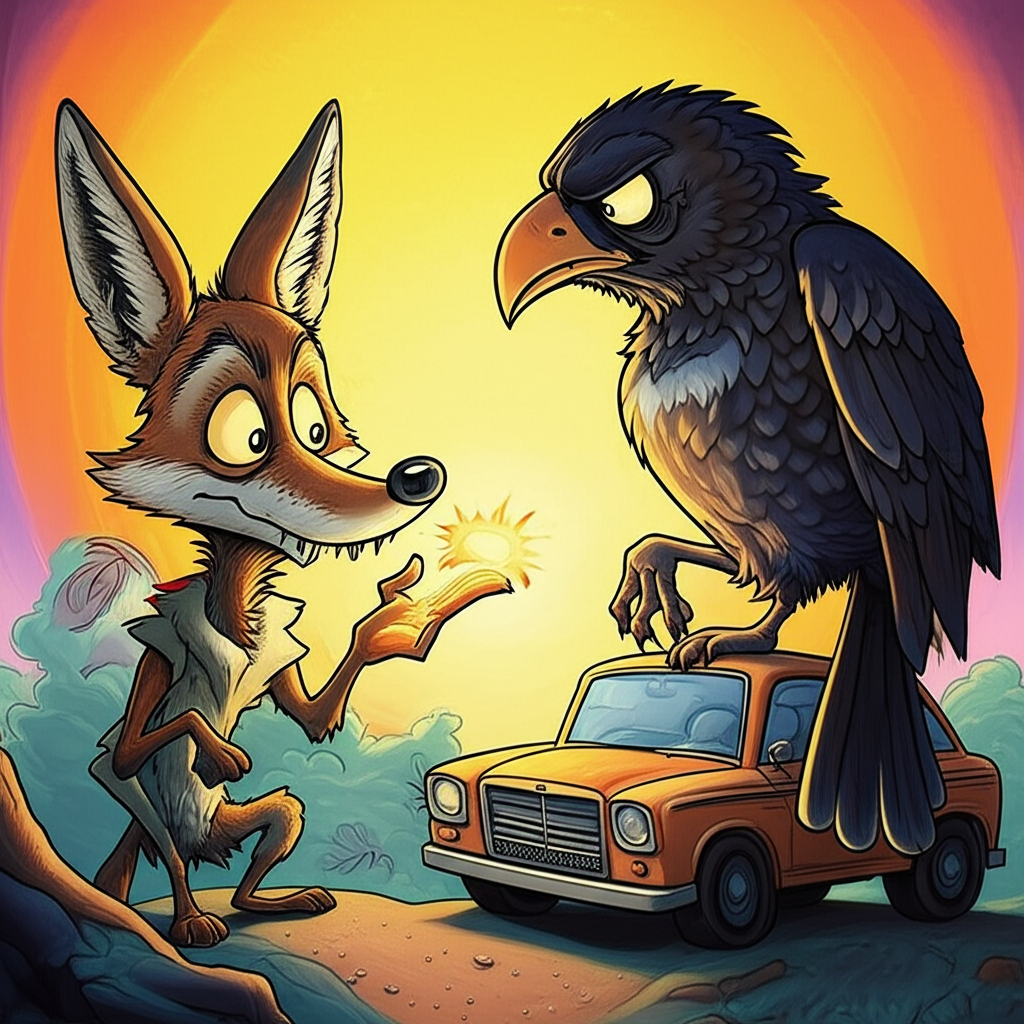
This article delves into a traditional story originating from the rich oral traditions of the Indigenous peoples of the Pacific Northwest Coast of North America. It is a myth, a legend passed down through generations by ancient people, offering insights into their worldview and understanding of the cosmos. This narrative, like countless others from cultures across the globe, is a product of human imagination and a means of making sense of the world, not a historical account or a religious doctrine to be believed or practiced. It is presented here purely for cultural, historical, and educational understanding.
Origins and Cultural Background: A World Shaped by Stories
The myth of Raven stealing the sun, and the subsequent weaving in of Coyote’s oath, is deeply embedded in the cultural fabric of Indigenous nations such as the Tlingit, Haida, Tsimshian, and others who have inhabited the verdant, rugged landscapes of the Pacific Northwest for millennia. These were societies intimately connected to their environment – the vast ocean, dense forests, and towering mountains provided both sustenance and inspiration. In the pre-colonial era, life revolved around the cycles of nature: salmon runs, berry harvests, and the ebb and flow of tides dictated daily existence.
For these ancient peoples, the world was not merely a collection of inanimate objects but a living, breathing entity imbued with spirit and consciousness. Animals, trees, rocks, and natural phenomena were often seen as kin, or as beings possessing their own power and wisdom. Their worldview was animistic and holistic, emphasizing the interconnectedness of all things. Stories were not mere entertainment; they were vital tools for education, moral instruction, historical record, and spiritual guidance. Through intricate narratives, often accompanied by elaborate carvings, dances, and ceremonies, knowledge was transmitted, social norms were reinforced, and the very identity of the community was preserved. In this environment, where the boundaries between the mundane and the miraculous were fluid, figures like Raven and Coyote emerged as powerful archetypes, embodying both the creative and chaotic forces of the universe.
The Trickster’s Guise: Raven and Coyote
In the pantheon of Indigenous mythologies, the figures of Raven and Coyote are quintessential tricksters – complex, multifaceted beings who defy simple categorization. They are not deities to be worshipped, but rather symbolic figures embodying the paradoxes of existence.
Raven, often referred to as "Grandfather Raven" or "Great Raven," is a central figure in Pacific Northwest cosmology. He is typically depicted as a shapeshifter, a being of immense power, intelligence, and insatiable curiosity. Raven is a creator, a transformer, and often a benevolent bringer of culture and necessities to humanity, such as light, fresh water, and salmon. Yet, he is also notoriously selfish, greedy, and mischievous, often acting out of personal desire rather than altruism, with positive outcomes often being an accidental byproduct of his trickery. He represents the cleverness and resourcefulness needed to navigate a complex world, as well as the unpredictable nature of change.
Coyote, prevalent in the mythologies of various North American Indigenous groups, particularly in the Plateau and Southwest regions, shares many traits with Raven, though his character often leans more towards outright buffoonery and self-serving antics. Like Raven, Coyote is a shapeshifter, a master of disguise, and a cunning schemer. He embodies both wisdom and foolishness, creation and destruction, order and chaos. Coyote often serves as a cultural hero, inadvertently teaching lessons through his mistakes, or by challenging established norms. He symbolizes adaptability, resilience, and the sometimes-disruptive force of change. Neither is purely good nor evil; they are reflections of the nuanced, often contradictory aspects of the natural world and human experience.
The Great Darkness and Coyote’s Vow
In the time before time, the world lay shrouded in perpetual darkness. The sky was a vast, inky blanket, and the people stumbled through their lives, cold and afraid. Food was scarce, for hunting was impossible, and the plants withered in the eternal night. All the light – the Sun, the Moon, and the Stars – was hoarded by a powerful, selfish Chief who kept them locked away in intricately carved wooden boxes within his longhouse, guarding them jealously.
It was in this age of gloom that Raven, in his ceaseless wandering, discovered the Chief’s secret. His sharp eyes, accustomed to navigating the gloom, perceived the faint glow emanating from the Chief’s dwelling. His curiosity piqued, Raven hatched a plan. He transformed himself into a tiny, almost invisible hemlock needle and floated unseen into the Chief’s lodge. There, he transformed again, this time into a crying baby, the Chief’s own grandson, left to lie upon a mat.
The Chief, delighted by his new grandson, lavished attention upon the child. Yet, the "baby" was inconsolable, crying relentlessly for the beautiful, glowing boxes that sat on the shelf. To quiet the child, the Chief, after much persuasion from his family, reluctantly handed over the smallest box. Raven, in his infant form, immediately stopped crying. He played with the box for a while, then, with a mischievous glint in his eyes, he transformed back into his true form, snatched the box, and burst out of the smoke hole, soaring into the sky.
High above the Chief’s lodge, Raven opened the first box, and out tumbled the Stars, scattering across the heavens like glittering dust. The world below was still dim, but now there was a faint, ethereal sparkle. Raven, exhilarated by his success, returned, once again transforming into the wailing infant. Again, he cried for another box, this time a larger one. The Chief, grumbling, eventually relented. Raven seized it, flew skyward, and opened the second box, releasing the brilliant, pearlescent Moon to sail through the starry expanse, casting a soft, silvery glow upon the land.
Still, Raven was not satisfied. He returned one last time, weeping for the largest, most radiant box of all. The Chief, weary and defeated, finally handed it over. With a triumphant cry, Raven flew higher than ever before, his powerful wings beating against the dawn. He opened the final box, and from it burst forth the glorious, golden Sun, illuminating the entire world in a breathtaking blaze of light.
As the Sun climbed into the sky, chasing away the ancient darkness, the world was transformed. Colors burst forth, mountains were revealed in their majestic glory, and the forests shimmered with new life. Animals blinked in the unaccustomed brilliance.
It was then, in this pivotal moment of creation, that Coyote emerged from the deep shadows of a ravine, his eyes squinting against the blinding light. He had watched Raven’s antics with a mixture of amusement and grudging respect. As the Sun’s first full rays warmed his fur, a profound shift occurred within Coyote. He was a creature of the twilight, of the in-between, thriving in the murky ambiguities of the shadowed world. But now, with the world ablaze in light, he knew his existence, too, must change.
With a sly grin, and a spark of cunning in his newly illuminated eyes, Coyote lifted his snout to the sky and let out a long, echoing howl – a declaration to the newly ordered world. It was his oath, not of fealty or submission, but of eternal, vibrant existence within this new reality. He swore that he, Coyote, would forever embody the spirit of the unpredictable, the mischievous, the ever-changing. He would wander the newly lit lands, weaving threads of chaos and unexpected wisdom into the tapestry of existence. He would challenge order, bring laughter and frustration, and ensure that even in the brightest light, the shadows of the untamed and the unexpected would always dance. His oath was a promise to remain the trickster, the shapeshifter, the embodiment of life’s dynamic, often contradictory nature, ensuring that the world, even with its new order, would never be entirely predictable.
Symbolism and Meaning
To the ancient peoples who told this story, the myth of Raven stealing the Sun and Coyote’s subsequent oath held profound symbolic meaning. Raven’s act explained the origin of daylight, night, and the celestial bodies, providing a foundational understanding of their cosmos. Beyond the literal explanation, Raven symbolized the power of resourcefulness and ingenuity, even if driven by selfish motives, to bring about significant change. His actions underscore the idea that creation can arise from unexpected, sometimes chaotic, sources. The light itself symbolized knowledge, life, warmth, and the order that allows for growth and sustenance. The transition from darkness to light represented a fundamental shift from a primordial, challenging existence to a world of possibility and clearer understanding.
Coyote’s oath, made in the wake of this cosmic transformation, added another layer of meaning. His vow to remain the embodiment of change and unpredictability, even in a newly ordered world, speaks to the acceptance of duality. It acknowledged that while light brings order, there would always be an inherent element of chaos, humor, and challenge in life. Coyote represented the human capacity for both brilliance and folly, the need to adapt to new circumstances, and the ongoing dance between structure and freedom. His oath affirmed that even with the grand cosmic order established, the world would remain a dynamic, spirited place, constantly evolving and surprising. It was a recognition that life, much like the trickster himself, is never entirely straightforward.
Modern Perspective: Echoes of Ancient Voices
Today, the myths of Raven and Coyote continue to resonate, finding new life in various forms. In literature, they are studied as prime examples of the "trickster archetype," a universal figure found in mythologies worldwide, embodying defiance, cunning, and the subversion of norms. Anthropologists and folklorists analyze these stories for insights into Indigenous cultures, worldviews, and social structures. Artists draw inspiration from their imagery, incorporating Raven and Coyote into contemporary carvings, paintings, and multimedia works that blend traditional aesthetics with modern interpretations.
In cultural studies, these myths are vital for understanding the resilience and richness of Indigenous oral traditions. They serve as powerful symbols of cultural identity and heritage, connecting modern generations with their ancestral past. Beyond academic and artistic spheres, elements of these stories occasionally appear in popular culture, from animated features to video games, albeit often in simplified or adapted forms. They remind us of humanity’s enduring fascination with the origins of the world and the complex nature of existence, as reflected through the lens of figures who are neither purely good nor evil, but profoundly human (or animal) in their motivations and consequences.
Conclusion: A Tapestry of Imagination
The narrative of Coyote and the Oath of Raven Steals the Sun is a profound example of the power of storytelling to convey cultural values, explain natural phenomena, and explore the complexities of human (and animal) nature. It is a traditional story, a vibrant thread in the rich tapestry of Indigenous oral traditions, passed down not as literal history or divine revelation, but as a framework for understanding and living in the world.
As Muslims, we recognize that Allah (God) alone is the true Creator and Sustainer of the heavens and the earth, the One who brought forth the sun, moon, and stars in perfect order, and fashioned all creation with ultimate wisdom and purpose. This understanding guides our faith and our perception of reality. Yet, we can also appreciate the beauty and ingenuity of human imagination expressed through such cultural narratives. These stories, like the myth explored here, stand as testaments to the universal human quest for meaning, the desire to comprehend the unknown, and the enduring power of shared cultural heritage to connect us across time and experience. They are imaginative reflections of how ancient communities understood their place in a wondrous, often mysterious, world.





